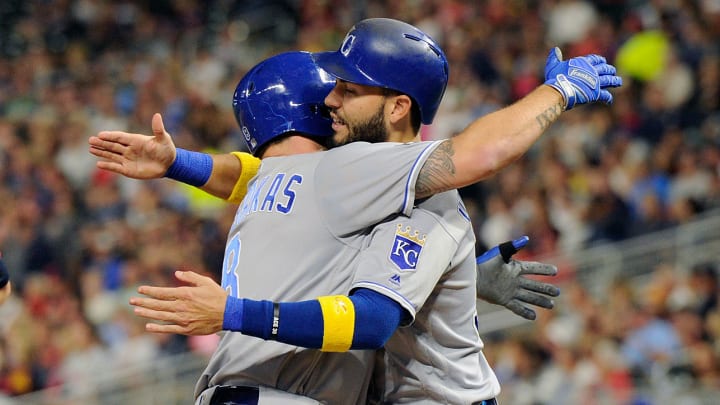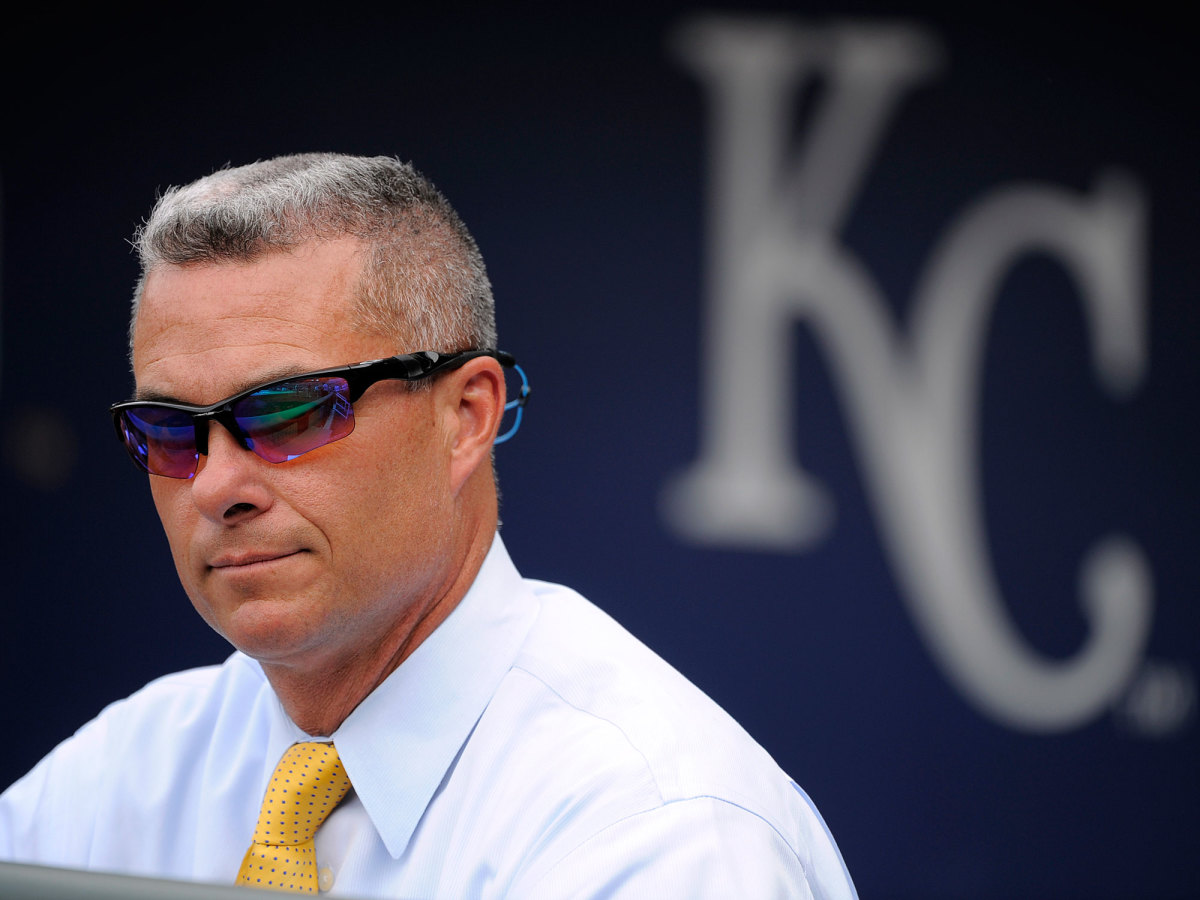The Royals' Last Dance: Kansas City Bet Big On Another Run With Its Core. Will It Pay Off?

Dayton Moore appeared to have only one strategic option in 2017: sell. The Royals G.M. simply had to, especially after the tragic off-season auto death of Yordano Ventura, which not only broke his club’s hearts but deprived it of a long-term, rotation-topping compliment to Danny Duffy. Most of the players who had formed the core of his lineup that won the AL pennant in 2014 and the World Series in '15—centerfielder Lorenzo Cain, shortstop Alcides Escobar, first baseman Eric Hosmer and third baseman Mike Moustakas—are due to become free agents at season’s end, as is starter Jason Vargas. The conventional wisdom held that Moore had no choice but to trade those players for prospects, as he had neither the minor leaguers nor the spending power to replace them. Doing so, the thinking went, would avert another long, playoff-free nuclear winter, such as the one Kansas City had experienced between 1986 and 2014.
But even after the Royals started this season by losing 20 of their first 30 games, Moore forbade the members of his front office from discussing the possibility of a mid-year rebuild. On July 24, a week before the non-waiver trade deadline that was supposed to represent the conclusion of his firesale, Moore bought, attempting to bolster his pitching staff with the Padres’ Trevor Cahill and Brandon Maurer.
It wasn’t long before a series of misfortunes struck. On Aug. 26, Duffy, the Royals’ only truly reliable starter, hit the disabled list with a left elbow impingement. The next day, he was arrested in Overland Park, Kans., under suspicion of driving under the influence, after allegedly passing out in his car in a Burger King drive-thru. Meanwhile, his teammates were in the midst of becoming the first club since 1992 to be shut out in four straight games—three of those at the hands of the ascendant Indians, who had begun to run away from them in the AL Central in historic fashion.
After beating the Twins on Sunday, the Royals are now 16-22 since the trade deadline. That performance has left Kansas City at 71-71, and because of the Indians’ 18-games-and-counting winning streak, the club is now 15 games behind in the division. And while the Royals are just 2 1/2 games out of the AL's second wild-card berth, there are five other trailing teams within 3 1/2 games of that spot. There seems to be only one conclusion: Dayton Moore screwed up, sacrificing his organization’s future for an irrational shot at one more playoff run. Right?
MLB Standings: Playoff, Wild-Card Races Plus Matchups If Season Ended Today
Perhaps not. It is easy to say that Moore could have restocked his farm system by flipping his impending free agents, but that ignores the conditions of a market in which teams have recently only wanted to part with top prospects for pitching, while most of the Royals’ impending free agents are hitters. The best hitter traded at the deadline was J.D. Martinez—a superstar who has baseball’s seventh-best OPS (.918) over the past four years and who has slugged 21 homers in 45 games for the Diamondbacks, including four on Sept. 4—but in exchange the Tigers failed to command even a single top 100-ranked minor leaguer from Arizona.
Moore still might have sold cheap but, as someone who was born in Wichita and attended Garden City Community College, he was wary of prematurely parting with players that had come not just to define his organization, but his community. “You’ve got people with Moose antlers on their cars driving around town, for Moustakas,” he told me last month. “You’ve got kids all over Kansas City with Hosmer haircuts. You’ve got to understand the climate here, the connectivity with these players.”

There was another reason Moore’s decision might not have been misguided: Though he might be outbid for their services this winter, Moore is not certain that all of his impending free agents—or even most of them—will be playing for somebody else next spring. When the Royals hired Moore in 2006, he arrived with a strong idea of the type of organization he hoped to build—one based on morals and selflessness. “We want our coaches, our staff members, our scouts to treat players like they’d want their own children treated,” says assistant G.M. J.J. Picollo.
That principle might sound hokey, but in a world in which employees, and not just ballplayers, are increasingly valued only for the metrics they produce it has often generated a loyalty between players and club that has had real results. Consider the a phenomenon that is often discussed in baseball but rarely seen in practice: the hometown discount.
Duffy, now 28, stunned the industry by signing a five-year, $65 million extension last winter—“There’s just no way I could think of wearing another jersey,” he said—just a year before he was due to reach a free agency in which he might have commanded even more.
The Real MVPs: Using Dollars And Sense To Figure Out MLB's Most Valuable Players
He wasn’t the first Royal to agree to a financial transaction with the club that befuddled outsiders. In 2011, injured pitcher Gil Meche told Moore that he couldn’t accept the $12 million he was owed on the final year of his contract,. Salvador Perez, an All-Star catcher in each of the past five seasons, has twice agreed to sub-market five-year contract extensions that will compensate him less than $60 million over that decade, rather than test the free agent waters. Leftfielder Alex Gordon did reach free agency two winters ago, only to reject better offers to return to the Royals for $72 million over four years.
Cain, Hosmer and Moustakas—currently three of the club’s four WAR leaders—might follow their predecessors’ lead, or they might not. “We genuinely wish our players the very best, and their families,” Moore said. “Whatever they think is in their best interest, that’s what we want. That’s not going to change. And at the end of the day, we’ll see what happens.”
Even if they do leave, the Royals aren’t necessarily doomed. Their farm system appears thin, but they have proven adept at developing unheralded minor leaguers into star-level contributors. Take second baseman Whit Merrifield, who is currently batting .284 with 17 homers and 27 steals in his first full season, or even Cain himself, who was never a top-100 prospect but has become an All-Star and was the MVP of the 2014 ALCS. And they retain at least one piece who fits the profile of a player for whom trade partners might actually pay up: fireballing closer Kelvin Herrera, who won’t become a free agent until after next season.
From 'Best Team Ever' To Worst Stretch Of The Year: What Has Happened To The Dodgers?
Finally, there is this: Despite their dispiriting recent play, the Royals’ immediate playoff hopes aren’t dead, not in the war of attrition that is this year’s AL wild card race. Even with all the traffic ahead of them, they remain just 2 1/2 games out, and only one of their remaining 20 contests—a Sept. 25 makeup game the wild-card leading Yankees in New York—comes against an opponent that has not already given up on its season or that might be unmotivated with its own playoff positions locked up (the Indians and Diamondbacks). “The fact that they won together, the fact that we understand the vitality of this team, of course we would give them the benefit of the doubt and not abandon the process,” Moore said in August.
The Royals’ process, of course, has never resembled that of any other club. They wouldn’t have risen to topple rivals with pockets several times deeper than their own if it had. Now, after the sell-off that wasn’t, only one thing is certain: If they continue to contend, not just this season but in the several to follow, it will be due to methods that are entirely their own.
